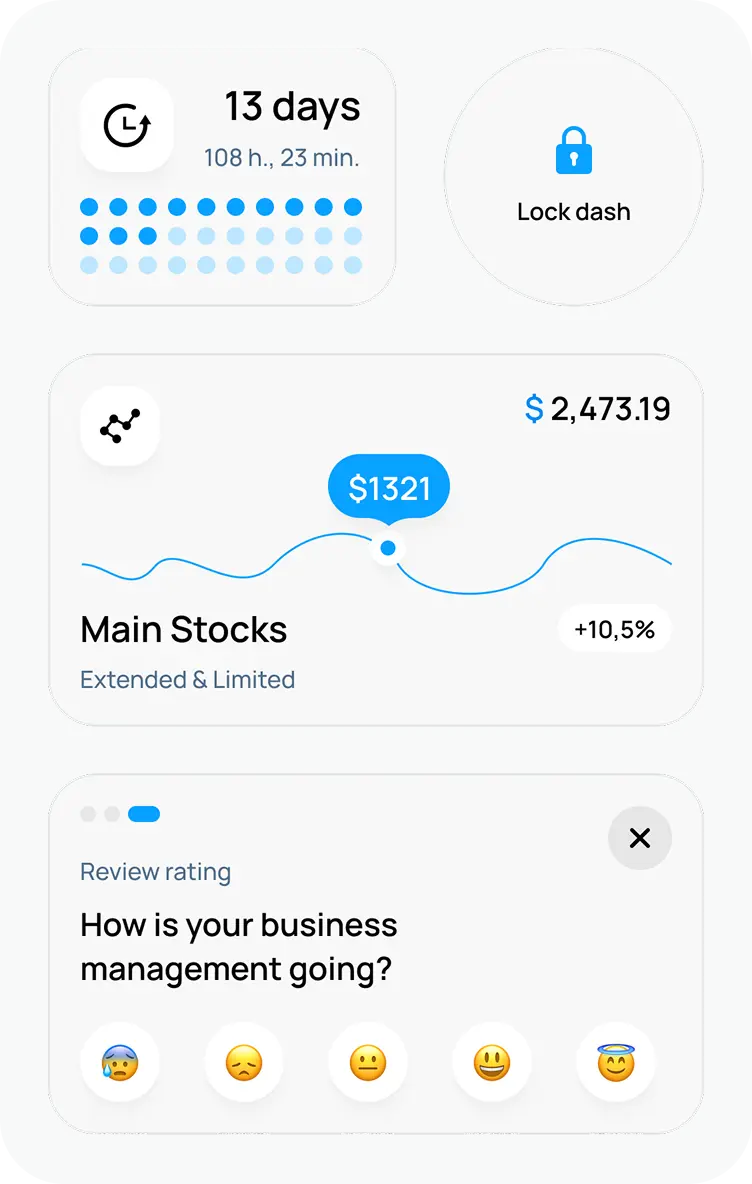React vs React Native: Complex Comparison
October 4, 2024•7 min read

I hope you enjoy reading this post. If you want us to do your frontend development or design, click here.
Author: Alex Vasylenko | Founder of The Frontend Company


The secret to The Frontend Company's success is our ability to choose the right tools for clients' projects. One of these tools is React — a powerful JavaScript library created and maintained by Meta, which is super popular in web development. And for a good reason.
Imagine that a web app is like a complex puzzle. React breaks it down into smaller, reusable pieces called "components." This modular approach means users can modify and update parts of the app independently without disturbing the rest. Simply, if you need to change one part, you can do so without causing chaos throughout the whole app.
One of React's best features is its use of a virtual DOM (Document Object Model). The virtual DOM is a lightweight copy of the actual DOM, a representation of the UI.
When you change the code, React compares the Virtual DOM to the Real DOM to see what needs to be updated. This clever trick makes everything super fast because it only updates the parts that need changing, not the entire page.
React is also user-friendly and easy to learn. For developers already familiar with JavaScript, React becomes a powerful tool that speeds up development and simplifies complex projects, makes you feel in control and empowered.
However, if React becomes your best friend for web development, React Native could be your go-to for mobile apps.
What is React Native? React Native takes your JavaScript code and turns it into the native language of both Android and iOS apps. In simple terms, it lets you build mobile apps without having to code for each platform separately.
Both of these frameworks — React and React Native — are powerful and necessary for modern web and mobile development. In this article, I will be the referee of the React Native vs React JS fight, explain the advantages and disadvantages of each, and get into the core difference between React and React Native.
ReactJS vs React Native. The main features.
React Main Features
1. Improved Performance
Virtual DOM magic makes React super fast for UI updates. All changes happen quickly and efficiently, giving web developers a smooth and dynamic experience.
2. Cross-Browser Compatibility
React works on all major browsers, whether your users are on a desktop or smartphone. This makes your app look and function the same everywhere and gives users a great experience no matter where they access it.
3. Reusable Components
React lets developers break down the UI into reusable pieces. Plus, each component can be developed and tested independently, contributing to easy maintenance and scaling for the most complex interfaces.
4. Strong Community
The React Community does a great job helping developers share knowledge and help each other out. This kind of support plays a vital role in overcoming project challenges.
5. Rich Ecosystem
From libraries to plugins, React offers lots of tools and resources. They make development easy and your code awesome.

Now, let's have a look at React Native's features.
React Native Main Features
With React Native, we get all the great features of React, specifically designed for building native mobile applications. So your apps will look, feel, and perform just like native apps — all with one codebase.
By using native APIs and platform-specific features, you can make apps that blend into the native environment. Here are the features that make React Native so special:
1. Cross Platform
React Native allows developers to build apps that work on both Android and iOS devices. With the ability to share most of the code between platforms, React Native reduces development time and ensures consistency across different devices.
2. Performance
React Native bridges JavaScript with native code, allowing the final product to behave like a native app. This means there are no performance glitches — just smooth operation, fast and responsive user experience.
3. Community
Like React, React Native has a big community of developers that contribute to the ecosystem. If you ever have a problem, the React and React Native community always has your back and make sure you can find solutions and resources to overcome challenges.
4. Live Changes
With React Native, any changes in the app code instantly come to life during development. This speeds up the development process by giving instant feedback and reducing the need to reload the app all the time.
5. Platform Flexibility
While React Native supports cross-platform development, you can easily dive into specific coding for Android or iOS.
Need React Native Developers?
React vs React Native Disadvantages
As you can see, both tools are good in their own way. But as always, they are far from perfect.
React Cons
• Fast Changes
React is changing fast, which is a blessing and a curse. New features and improvements are being added frequently, but this fast pace can make it hard for developers to keep up with the changes and updates.
They lead to compatibility issues with existing code or libraries, requiring developers to update their projects to the latest version of React all the time.
• JSX Complexity
While JavaScript is powerful, JSX can complicate your code. JSX is a syntax extension for JavaScript that allows you to write HTML-like code in your JavaScript.
The combination of HTML-like syntax in JavaScript can make the code harder to read, especially for developers who are not familiar with JSX. Although you can use React without JSX, many developers like its clarity and visibility when working with UIs embedded directly in JavaScript code.
• Documentation issues
React's fast-paced updates leave little time for comprehensive documentation. This can result to incomplete or outdated documentation, and developers have to rely on community resources or create their own guides to understand new features and releases.
• Tech Dependencies
Depending on technologies like JavaScript, DOM, TypeScript, and Redux can limit React's flexibility, and this problem makes it less suitable for specific tasks.
• Narrow Focus
React specializes in UI layers. You need additional technologies for a complete development toolkit, like routing libraries, state management tools, or backend frameworks.
• Browser Boundaries
React may struggle on older browsers because of its reliance on modern web technologies. While that is not a big issue for most users, it's a limitation for users who use older devices or browsers that do not fully support React's features.
Now, let's go to the disadvantages of React Native.
React Native Cons
React Native has many benefits, but it’s not without its drawbacks. Here are some of the cons to keep in mind:
• Hard to Learn
React Native is harder to learn than React. The combination of JavaScript and native mobile development makes the onboarding process more difficult, especially if developers are more used to web development.
• Security Issues
Being JavaScript-based and open-source, React Native may not be secure enough for highly sensitive apps like finance or healthcare.
• Slow to Start
React Native can take a long time to start, even on powerful devices.
• Hard to debug
Debugging can be challenging due to the potential errors in native code, making it harder to detect issues. Developers will need additional tools and knowledge to debug React Native applications.
• Limited Native Access
React Native gives you access to many native APIs, but it's still limited compared to fully native development. For apps that need complex native features or deep integration with device-specific functionality, developers may find React Native's capabilities restrictive and will need to find workarounds or have native development expertise.

Transform your UI for peak performance!
🔹
Unlock seamless, high-performance frontend solutions tailored to your business.
🔹
Get an interface that outshines competitors and delights your users.
React JS vs React Native. What do they have in common?
React and React Native are siblings because they have a lot in common. Here are some of the things they share:
• Same Syntax
React and React Native have the same syntax. So, if you’re already familiar with React, transitioning to web and mobile development will be easier.
• Component-based structure
Both React and React Native are component-based structures, so you can break down your app into smaller pieces.
• Programming language
React and React Native use JavaScript as their primary language. This means you can use the same language across different platforms and make the development easier.
• Virtual DOM
Both technologies use a virtual DOM (or a similar concept in React Native's case) to render applications. This helps with performance by updating only the necessary parts of the UI instead of reloading the whole page or view.
• Styling
While both React and React Native use similar styling techniques, they approach it differently. React Native has a styling system that is similar to CSS but optimized for mobile development, so developers have familiar but specialized tools to style mobile apps.
• Debugging tools
Both React Native and React use Chrome DevTools for debugging.
• JavaScript APIs
React and React Native use the same JavaScript APIs, so developers can build robust applications with the same tools.
As you can see, these two technologies have a lot in common, and you can switch between them with a consistent workflow.
React Native vs React. Core Differences

While React and React Native share many similarities, they each shine in different areas. React is great for building dynamic and interactive web applications, using its virtual DOM and component-based structure to improve performance and maintainability. It's easy to learn, and its strong community support makes it a favorite among web developers.
React Native takes these advantages to the mobile development world. By allowing developers to write code once and deploy it to both iOS and Android, React Native is a powerful solution for building native mobile apps with a shared codebase.
Conclusion
At The Frontend Company, we know the difference between React JS and React Native, as I showed above.
As one of the top frontend development companies, we are here to guide you through every step of the process and bring your idea to life. Fill out the form on our website, and we will contact you within 24 hours to discuss your project and create a proposal based on your needs, budget, and timeline.

Unlock the full potential of your product

Boost customer retention & satisfaction

Become more competitive on the market

Move to the latest technologies stacks

Improve usability & visual appeal
FAQ

Alex Vasylenko is the founder of The Frontend Company, DBC and several other successful startups. A dynamic tech entrepreneur, he began his career as a frontend developer at Deloitte and Scandinavia's largest banking company. In 2023, Alex was honored as one of 'Top 10 Emerging Entrepreneurs' by USA Today.
RATE
Rate this article please
This will help us provide more useful information.
211 ratings, average 4.97 out of 5
